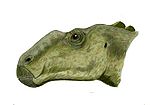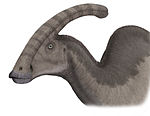- Dinosaur reproduction
-
Dinosaur reproduction was sexual, with newborns hatching from eggs.
Contents
Medullary bone
A discovery of features in a Tyrannosaurus rex skeleton recently provided more evidence that dinosaurs and birds evolved from a common ancestor and, for the first time, allowed paleontologists to establish the sex of a dinosaur. When laying eggs, female birds grow a special type of bone between the hard outer bone and the marrow of their limbs. This medullary bone, which is rich in calcium, is used to make eggshells. The presence of endosteally derived bone tissues lining the interior marrow cavities of portions of the Tyrannosaurus rex specimen's hind limb suggested that T. rex used similar reproductive strategies, and revealed the specimen to be female.[1] Further research has found medullary bone in the theropod Allosaurus and the ornithopod Tenontosaurus. Because the line of dinosaurs that includes Allosaurus and Tyrannosaurus diverged from the line that led to Tenontosaurus very early in the evolution of dinosaurs, this suggests that dinosaurs in general produced medullary tissue. Medullary bone has been found in specimens of sub-adult size, which suggests that dinosaurs reached sexual maturity rather quickly for such large animals.[2]
Ornithopod reproduction
Hadrosaur reproduction
In the Dinosaur Park Formation
In 2001 Darren H. Tanke and M. K. Brett-Surman reviewed and described eggshell and hatchling material from the Dinosaur Park Formation of Dinosaur Provincial Park.[3] Eggshell is rare in the Park, being present in only two microfossil sites, both of which are predominated by the preserved shells of invertebrate life.[3] The survival of hadrosaur eggshell fragments in the presence of these invertebrate shells may be result of calcium in the invertebrate shells buffering contemporary acidic water which would have dissolved them.[3] The hadrosaur eggshell fragments "show little to no stream abrasion" suggesting that the material did not originate far from their final burial place in the Park.[3] The authors felt that their newly reported material corroborated the then-recent suggestion that hadrosaurs did not nest exclusively in upland areas, but also areas of lower elevation.[3] Some recovered hadrosaur fossils might actually be from embryos.[4] Hatchling and nestling-sized hadrosaur remains had been falsely considered rare in Dinosaur Park Formation due to bias on the part of collectors seeking larger specimens and sometimes not recognizing what was encountered.[4] Hadrosaurs had been speculated to be upland breeders due to the lack of preserved egg and hatchling material.[4]
However young hadrosaur remains had been previously reported from lowland deposits.[4] Darren Tanke observed that an experienced collector could actually discover multiple juvenile hadrosaur specimens a day.[4] During the 1992 field season a concerted effort was undertaken by the Royal Tyrell Museum to recover the remains of young hadrosaurs.[4] The researchers describe the acquisition that season of 43 specimens as being a success.[4] Most of the recovered fossils were of dentaries missing their teeth, bones from limbs and feet, as well as vertebral centra.[4] The material showed little or none of the abrasion that would have resulted from transport, meaning the fossils were buried near their point of origin.[4] The researchers conclude that this meant that hadrosaurs were nesting in the lowlands of the area represented by the strata containing the fossils and that previous workers hypotheses of lowland hadrosaur breeding were "confirmed."[4] Most of the shells from the microfossil site are from pisidiid clams, but rarely unionid clams and gastropods are found.[5] It was the slow dissolution of these shells releasing calcium carbonate into the water that raised the water's pH high enough to prevent the eggshells from dissolving.[5] The no fragment's greatest dimension exceeds one cm.[5] The eggshells' surface has a pebbly texture.[5] The eggshell is similar to the eggshells from the Two Medicine and Judith River Formations in Montana.[5] Dinosaur eggshell can have different textures on different parts of the egg.[5]
Most hadrosaur neonate bones are incomplete due to their small size and vulnerability to the high erosion rates in the Dinosaur PRovincial Park.[6] Dentaries are common hadrosaur neonate fossils.[6] Most specimens don't preserve all of the tooth replacement gooves.[6] Most preserve "only about [ten] tooth files."[6]
No neural arches are represented among the vertebrae fossils.[7] Although some limb bones show signs of transport wear, the distances traveled before burial were probably not far as such small bones would be unlikely to survive the great diversity of scavengers and acidic water conditions.[8] The breakdown of tannins from coniferous vegetation would have caused the pH of the waters in the park to be acidic.[9] Dinosaur eggshell is lacking from the bone beds producing the hadrosaur juvenile bones.[9]
The authors concluded that hadrosaurs nested in both upland or lowland area, although described factors influencing the division of breeding locations as unknown.[10] They suggested that "diet, soil conditions, habits, [and] competition" between dinosaur genera might have played roles.[10] Some of the less common hadrosaurs in the Dinosaur Park Formation of Dinosaur Provincial Park like Brachylophosaurus or Parasaurolophus may have had a more upland habitat where they may have nested or fed.[10]
Footnotes
- ^ Schweitzer, et al. (2005).
- ^ Lee and Werning (2008).
- ^ a b c d e "Abstract," Tanke and Brett-Surman (2001). Page 206.
- ^ a b c d e f g h i j "Introduction," Tanke and Brett-Surman (2001). Page 208.
- ^ a b c d e f "Eggshell," Tanke and Brett-Surman (2001). Page 209.
- ^ a b c d "Bones," Tanke and Brett-Surman (2001). Page 209.
- ^ "Bones," Tanke and Brett-Surman (2001). Page 211.
- ^ "Discussion," Tanke and Brett-Surman (2001). Pages 211-212.
- ^ a b "Discussion," Tanke and Brett-Surman (2001). Page 212.
- ^ a b c "Conclusions," Tanke and Brett-Surman (2001). Page 212.
References
- Lee, Andrew H.; Werning, S (2008). "Sexual maturity in growing dinosaurs does not fit reptilian growth models". Proceedings of the National Academy of Sciences 105 (2): 582–587. doi:10.1073/pnas.0708903105. PMC 2206579. PMID 18195356. http://www.pnas.org/cgi/content/abstract/105/2/582.
- Schweitzer, M.H.; Wittmeyer, JL; Horner, JR (2005). "Gender-specific reproductive tissue in ratites and Tyrannosaurus rex". Science 308 (5727): 1456–1460. doi:10.1126/science.1112158. PMID 15933198. http://www.sciencemag.org/cgi/content/abstract/308/5727/1456.
- Tanke, D.H. and Brett-Surman, M.K. 2001. Evidence of Hatchling and Nestling-Size Hadrosaurs (Reptilia:Ornithischia) from Dinosaur Provincial Park (Dinosaur Park Formation: Campanian), Alberta, Canada. pp. 206–218. In: Mesozoic Vertebrate Life—New Research Inspired by the Paleontology of Philip J. Currie. Edited by D.H. Tanke and K. Carpenter. Indiana University Press: Bloomington. xviii + 577 pp.
Categories:- Dinosaurs
Wikimedia Foundation. 2010.



